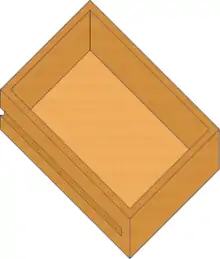Drawer
A drawer /drɔːr/ (![]() listen) DROR is a box-shaped container that fits into a piece of furniture in such a way that it can be drawn out horizontally to reach its contents. Drawers are built into numerous types of furniture, including cabinets, chests of drawers (bureaus) and the like.
listen) DROR is a box-shaped container that fits into a piece of furniture in such a way that it can be drawn out horizontally to reach its contents. Drawers are built into numerous types of furniture, including cabinets, chests of drawers (bureaus) and the like.


Construction
Drawers can be built in a variety of manners using a variety of materials. Wood and various wood composites, sheet metal, & plastic are common materials used for drawers and the furniture that the drawer is contained in.
Wooden drawers are often designed so that the front face is complete and the end grain from the side pieces does not show. The corners may be dovetailed for additional strength or for aesthetics,[1] and a half-blind dovetail joint may be used for the front corners to hide the joint. To attach the bottom piece of the drawer, a groove may be cut in the four vertical pieces to insert the bottom of the drawer.
Handles and locks
Most commonly, one or two handles or drawer pulls are attached to the front face of the drawer to facilitate pulling it out from its enclosure. In some cases, drawers may have another means by which to pull it, including holes cut in the front face or a hollowed-out area to insert the fingers on the bottom side of the front face of the drawer.
Some drawers incorporate a locking mechanism to secure the drawer. This is commonly found in filing cabinet and desk drawers.
Movement
Most older or inexpensive pieces of furniture and cabinets use wooden sliders, upon which the drawer slides as it is opened or closed. Wood slides can be lubricated with paraffin wax. Newer furniture and cabinets may use plastic friction slides, or more elaborate bearings slide, which will provide smoother operation with less binding. There are different types of bearing slides, such as linear ball-bearing slides, roller bearing slides, progressive action slides. Modern drawer slides are usually categorized in how they are mounted, including center mount, side mount, bottom mount and European mount drawer slides. Drawer slides are intended for use varying from light to heavy drawers and thus contain load ratings ranging from 75–450 pounds (34–204 kg). A load rating of 100 pounds (45 kg) is considered typical.
Drawer slides often have a mechanism to keep the drawer from accidentally being pulled fully from its enclosure. See also Drawer slides 101 What is a drawer slide
With the simplest kinds of mounting, the drawer cannot be pulled out sufficiently to see the full interior, without pulling the drawer completely out of the cabinet, often leading to the contents being dumped on the floor.[2][3] There are at least two ways to make the full interior of a drawer visible, while still being completely supported by the cabinet.
One way places the back of the drawer such that it is fully visible when the drawer hits the stop -- the interior of such a drawer is much shorter than the sides of the drawer.[2] That visible back of the drawer may be a false back that conceals a secret hiding place behind it.[4] Another way uses full extension drawers, which have full-extension drawer slides, also called telescoping slides, a kind of linear-motion bearing § Compound slides that support the drawer even when the drawer is pulled entirely out of the cabinet.[3][5][6][7]
Types of drawer slide
| Item | Type | Mounting | Pro | Con |
|---|---|---|---|---|
| 1 | Ball bearing drawer slides | side mount | full extension to achieve maximum use of space | visible when one opens drawer |
| 2 | Center mounted slide | bottom mount at drawer center | invisible when one opens a drawer | light loading |
| 3 | under mounted slide | at two sides of a drawer bottom | with built-in soft close | high cost |
| 4 | European slide | side mount | heavy loading | limited space to slide out |
References
- Jerzy Smardzewski Furniture Design, p. 67, at Google Books
- Alvan C. Nye. "Notes on Furniture Draughting". "American Architect and Architecture, Volume 46". 1894. p. 58.
- Alvan Crocker Nye. "Furniture Designing and Draughting". 1907. p. 85.
- Carol Beronich. "Built-In Secret Spaces". 2019.
- Carol Schaake et al. "Residential Remodeling and Universal Design". 1996. p. 38.
- "The Accessible Housing Design File". 1991. p. 207.
- Jeanne Huber. "Complete Home Storage". 2007. p. 65
- Cabrera, Heilyn (2017), Drawer slide types, Hunker
- Slide Rail, Shelves that Slide, 2017